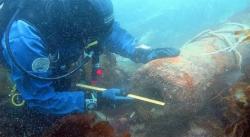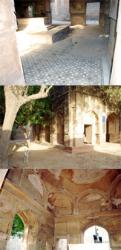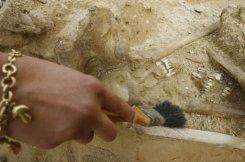INSTITUT SUPERIEUR D'ANTHROPOLOGIE
INSTITUTE OF ANTHROPOLOGY
ONLINE COURSES / COURS A DISTANCE
INSCRIPTION 2012 / Session III : Juillet 2012
REGISTRATION 2012 / Term III : July 2012
FRANCE –  Usseau - Les archéologues de l'Inrap viennent de découvrir une nouvelle nécropole mérovingienne à Usseau. Cette exhumation d'une page d'histoire de France récente (entre le VIe et le VIIIe siècle après Jésus-Christ) devrait permettre très rapidement aux chercheurs de connaître un peu mieux cette période de transition entre le déclin de l'empire romain et la naissance du peuple des Francs. Dans cette petite commune entre Niort et La Rochelle, on connaissait déjà la voie gallo-romaine qui reliait Angers à Saintes dès la période antique. En 2001, au Fief-Dampierre, l'équipe de l'archéologue Christian Scuiller, de l'Inrap, avait mis au jour une première nécropole comprenant de nombreux sarcophages et autres sépultures en fosse. A quelques dizaines de mètres de ce même site, rue de la Laiterie, les scientifiques viennent d'identifier dans le cadre de nouvelles fouilles 150 sépultures en fosse et 9 sarcophages. Dans certaines de ces sépultures ont été retrouvés divers objets : un couteau, une boucle de ceinture ayant appartenu à une femme et de la monnaie. Ces « trésors » viennent enrichir une collection déjà bien complète. Les sarcophages ont été taillés dans des calcaires, orientés dans le sens est-ouest et comptent chacun d'un à quatre individus. L'archéologue Christian Scuiller qualifie cette dernière découverte de « formidable ». Elle lui permettra de cerner encore un peu mieux la période qui court du IIe au IXe siècle. Une analyse ADN des squelettes ne sera pas possible. « Faute de moyens financiers », précise Anne-Marie Cottenceau, la directrice de la direction régionale des Affaires culturelles. Les ossements vont être étudiés plus longuement d'ici quelques jours, en laboratoire, par des paléoanthropologues. Ceux-ci vont tenter de déterminer les pathologies de certaines de ces personnes au moment de leur décès.
Usseau - Les archéologues de l'Inrap viennent de découvrir une nouvelle nécropole mérovingienne à Usseau. Cette exhumation d'une page d'histoire de France récente (entre le VIe et le VIIIe siècle après Jésus-Christ) devrait permettre très rapidement aux chercheurs de connaître un peu mieux cette période de transition entre le déclin de l'empire romain et la naissance du peuple des Francs. Dans cette petite commune entre Niort et La Rochelle, on connaissait déjà la voie gallo-romaine qui reliait Angers à Saintes dès la période antique. En 2001, au Fief-Dampierre, l'équipe de l'archéologue Christian Scuiller, de l'Inrap, avait mis au jour une première nécropole comprenant de nombreux sarcophages et autres sépultures en fosse. A quelques dizaines de mètres de ce même site, rue de la Laiterie, les scientifiques viennent d'identifier dans le cadre de nouvelles fouilles 150 sépultures en fosse et 9 sarcophages. Dans certaines de ces sépultures ont été retrouvés divers objets : un couteau, une boucle de ceinture ayant appartenu à une femme et de la monnaie. Ces « trésors » viennent enrichir une collection déjà bien complète. Les sarcophages ont été taillés dans des calcaires, orientés dans le sens est-ouest et comptent chacun d'un à quatre individus. L'archéologue Christian Scuiller qualifie cette dernière découverte de « formidable ». Elle lui permettra de cerner encore un peu mieux la période qui court du IIe au IXe siècle. Une analyse ADN des squelettes ne sera pas possible. « Faute de moyens financiers », précise Anne-Marie Cottenceau, la directrice de la direction régionale des Affaires culturelles. Les ossements vont être étudiés plus longuement d'ici quelques jours, en laboratoire, par des paléoanthropologues. Ceux-ci vont tenter de déterminer les pathologies de certaines de ces personnes au moment de leur décès.
http://www.lanouvellerepublique.fr/Deux-Sevres/Loisirs/24H/n/Contenus/Articles/2012/05/31/Une-nouvelle-necropole-exhumee-a-Usseau
PHILIPPINES –  Ambangan - Two decades after the first three balanghai boats were dug out, six archaeologists from the Philippine National Museum in Manila, together with personnel from the Regional Museum here, began last week excavation of the fourth ancient boat in the site the previous three were dug back in the 1980s. As of today, archaeologists have already dug six to seven feet deep at the Ambangan site in Barangay Libertad here, showing about 30 percent of the balanghai. Wilfredo Ronquillo, chief archaeologist at the Philippine National Museum, expressed how amazed he and his team are of the rich historic cultural heritage of Butuan. He noted that there are slight differences in how the fourth balanghai excavated was constructed compared to the previous boats dug more than two decades ago. “They are not identical, although the general scheme is almost the same. The artistic ways of each boat maker, what we can see here is the skill of our early predecessors. When they made this, there was no blueprint, no plans. It is just amazing,” said Ronquillo. Ligaya Lacsina, researcher at the archaeology division of the National Museum, said that comparing the balanghai to boats unearthed in Indonesia and Malaysia showed that ancient Filipino boat makers used similar boat construction techniques with their Southeast Asian neighbors. “They use the same shell-first boat building technique, with the planks connected edge to edge using wooden dowels,” said Lacsina, who is currently on taking up doctorate study on archaeology in Australia, focusing more on traditional boat building, especially on Southeast Asian boat building traditions. In the oldest excavation site in Malaysia, she pointed out, the boats were dated around the third and fourth century A.D. The flotilla of balanghai boats was accidentally discovered by treasure hunters back in 1976. Archaeologists from the National Museum took over the site and discovered nine boats buried in the ground. From the nine original boats discovered in Barangay Libertad, three were excavated. One is now displayed at a shrine at the excavation site, another is at the Maritime Hall of the National Museum in Manila. The third, which is the most damaged, is being kept by the local branch of the National Museum here in Butuan. The oldest was dated at 320 AD, the next 900 AD, and the third 1250 AD. Historians say that the discovery of the boats showed that Butuan was once an old sea-fearing kingdom trading with the Srivijayan Empire in Southeast Asia and even as far away as China more than a thousand years ago.
Ambangan - Two decades after the first three balanghai boats were dug out, six archaeologists from the Philippine National Museum in Manila, together with personnel from the Regional Museum here, began last week excavation of the fourth ancient boat in the site the previous three were dug back in the 1980s. As of today, archaeologists have already dug six to seven feet deep at the Ambangan site in Barangay Libertad here, showing about 30 percent of the balanghai. Wilfredo Ronquillo, chief archaeologist at the Philippine National Museum, expressed how amazed he and his team are of the rich historic cultural heritage of Butuan. He noted that there are slight differences in how the fourth balanghai excavated was constructed compared to the previous boats dug more than two decades ago. “They are not identical, although the general scheme is almost the same. The artistic ways of each boat maker, what we can see here is the skill of our early predecessors. When they made this, there was no blueprint, no plans. It is just amazing,” said Ronquillo. Ligaya Lacsina, researcher at the archaeology division of the National Museum, said that comparing the balanghai to boats unearthed in Indonesia and Malaysia showed that ancient Filipino boat makers used similar boat construction techniques with their Southeast Asian neighbors. “They use the same shell-first boat building technique, with the planks connected edge to edge using wooden dowels,” said Lacsina, who is currently on taking up doctorate study on archaeology in Australia, focusing more on traditional boat building, especially on Southeast Asian boat building traditions. In the oldest excavation site in Malaysia, she pointed out, the boats were dated around the third and fourth century A.D. The flotilla of balanghai boats was accidentally discovered by treasure hunters back in 1976. Archaeologists from the National Museum took over the site and discovered nine boats buried in the ground. From the nine original boats discovered in Barangay Libertad, three were excavated. One is now displayed at a shrine at the excavation site, another is at the Maritime Hall of the National Museum in Manila. The third, which is the most damaged, is being kept by the local branch of the National Museum here in Butuan. The oldest was dated at 320 AD, the next 900 AD, and the third 1250 AD. Historians say that the discovery of the boats showed that Butuan was once an old sea-fearing kingdom trading with the Srivijayan Empire in Southeast Asia and even as far away as China more than a thousand years ago.
http://www.mindanews.com/top-stories/2012/05/31/archaeologists-begin-excavation-of-4th-balanghai-in-butuan/
ROYAUME UNI –  Plymouth Sound - Long-lost treasures and historical artifacts dating back centuries are being discovered in Plymouth Sound in the first ever major archaeological survey of its kind. A huge US-led marine research and exploration project is currently under way in the city to discovery the secrets of the Sound. since June 2010, the ProMare team has been focused on uncovering the hidden gems underwater in Plymouth Sound. "Since we began we have found evidence of up to 800 shipwrecks in Plymouth Sound alone," said Ayse Atauz the president of ProMare who has re-located to Plymouth. "We've found ancient wooden ships, ceramics and pottery and cannons to name just a few things. "We've found hundreds of new artifacts and targets in Plymouth Sound since we started in 2010. "It has been used since Roman times or even before then. We've even discovered evidence of Viking settlements in the Tamar area. "Most of these are of national and international significance. We know that Plymouth has been extremely important over the centuries as a port. "It was one of the major ports for the south of England. The history of anchorage here goes back to when people first began to go to sea. "This is the first ever major archaeological survey of Plymouth Sound. It's the first attempt at a systematic survey of the Sound."
Plymouth Sound - Long-lost treasures and historical artifacts dating back centuries are being discovered in Plymouth Sound in the first ever major archaeological survey of its kind. A huge US-led marine research and exploration project is currently under way in the city to discovery the secrets of the Sound. since June 2010, the ProMare team has been focused on uncovering the hidden gems underwater in Plymouth Sound. "Since we began we have found evidence of up to 800 shipwrecks in Plymouth Sound alone," said Ayse Atauz the president of ProMare who has re-located to Plymouth. "We've found ancient wooden ships, ceramics and pottery and cannons to name just a few things. "We've found hundreds of new artifacts and targets in Plymouth Sound since we started in 2010. "It has been used since Roman times or even before then. We've even discovered evidence of Viking settlements in the Tamar area. "Most of these are of national and international significance. We know that Plymouth has been extremely important over the centuries as a port. "It was one of the major ports for the south of England. The history of anchorage here goes back to when people first began to go to sea. "This is the first ever major archaeological survey of Plymouth Sound. It's the first attempt at a systematic survey of the Sound."
http://www.thisisplymouth.co.uk/Major-archaeological-survey-uncovers-secrets/story-16235918-detail/story.html
PAKISTAN –  Lahore - The 381-year-old tomb of Mughal Princess Zebunnisa, situated on Multan Road, adjacent to Samanabad Morr, is in dire need of renovation and conservation. Zebunnisa was the daughter of Mughal Emperor Aurangzeb Alamgeer. She lived life of a maiden and gave all her time to literary works and poetry. She died in 1669. The tomb was owned and maintained by the Punjab government’s Directorate of Archaeology. It had been declared a “protected monument” under the Ancient Monument Preservation Act, 1904, now Antiquities Act, 1975. The monument, however, stands in a dilapidated condition, with the grave being only 10 foot above the ground level. It is surrounded by encroachments – a wood-cutting workshop on right side of the entrance and houses on all sides. Inmates of the houses built around the tomb throw their garbage in the tomb’s compound. The tomb also served as an entrance to one of the houses built at its rear. Tile work on the tomb’s floor, which had carried out by the Archaeology Department a few years ago, is all broken now with tiles displaced from their original positions. The thin red brick floor surrounding the tomb is also broken, exposing the soft mud floor underneath. Mosaic work on the ceiling and walls has also vanished and walls have turned black with fungus, giving an ugly look to the tomb. The four big entrances and eight small ones are in ruins, with the lower portions lacking any protective plaster material, revealing the broken small bricks below. The main rounded big dome over the monument has turned black with fungus and pollution.
Lahore - The 381-year-old tomb of Mughal Princess Zebunnisa, situated on Multan Road, adjacent to Samanabad Morr, is in dire need of renovation and conservation. Zebunnisa was the daughter of Mughal Emperor Aurangzeb Alamgeer. She lived life of a maiden and gave all her time to literary works and poetry. She died in 1669. The tomb was owned and maintained by the Punjab government’s Directorate of Archaeology. It had been declared a “protected monument” under the Ancient Monument Preservation Act, 1904, now Antiquities Act, 1975. The monument, however, stands in a dilapidated condition, with the grave being only 10 foot above the ground level. It is surrounded by encroachments – a wood-cutting workshop on right side of the entrance and houses on all sides. Inmates of the houses built around the tomb throw their garbage in the tomb’s compound. The tomb also served as an entrance to one of the houses built at its rear. Tile work on the tomb’s floor, which had carried out by the Archaeology Department a few years ago, is all broken now with tiles displaced from their original positions. The thin red brick floor surrounding the tomb is also broken, exposing the soft mud floor underneath. Mosaic work on the ceiling and walls has also vanished and walls have turned black with fungus, giving an ugly look to the tomb. The four big entrances and eight small ones are in ruins, with the lower portions lacking any protective plaster material, revealing the broken small bricks below. The main rounded big dome over the monument has turned black with fungus and pollution.
http://www.dailytimes.com.pk/default.asp?page=2012%5C05%5C31%5Cstory_31-5-2012_pg13_6
ITALIE –  - Italian police said Wednesday they had reported five people to prosecutors after finding and impounding some 18,000 ancient artifacts dug up in illegal excavations at archaeological sites near Rome. Police have also sealed off three illegal dig sites previously unknown to archaeologists, they said in a statement: a necropolis dating from the Roman empire, a Roman villa and a sanctuary used by the Aequi people, who lived in an area northeast of Rome in the fourth and fifth centuries BC. The items impounded include ancient artworks, Roman sarcophagi and engraved stones known as stela.
- Italian police said Wednesday they had reported five people to prosecutors after finding and impounding some 18,000 ancient artifacts dug up in illegal excavations at archaeological sites near Rome. Police have also sealed off three illegal dig sites previously unknown to archaeologists, they said in a statement: a necropolis dating from the Roman empire, a Roman villa and a sanctuary used by the Aequi people, who lived in an area northeast of Rome in the fourth and fifth centuries BC. The items impounded include ancient artworks, Roman sarcophagi and engraved stones known as stela.
http://www.france24.com/en/20120530-italian-police-impound-18000-illegally-excavated-artifacts